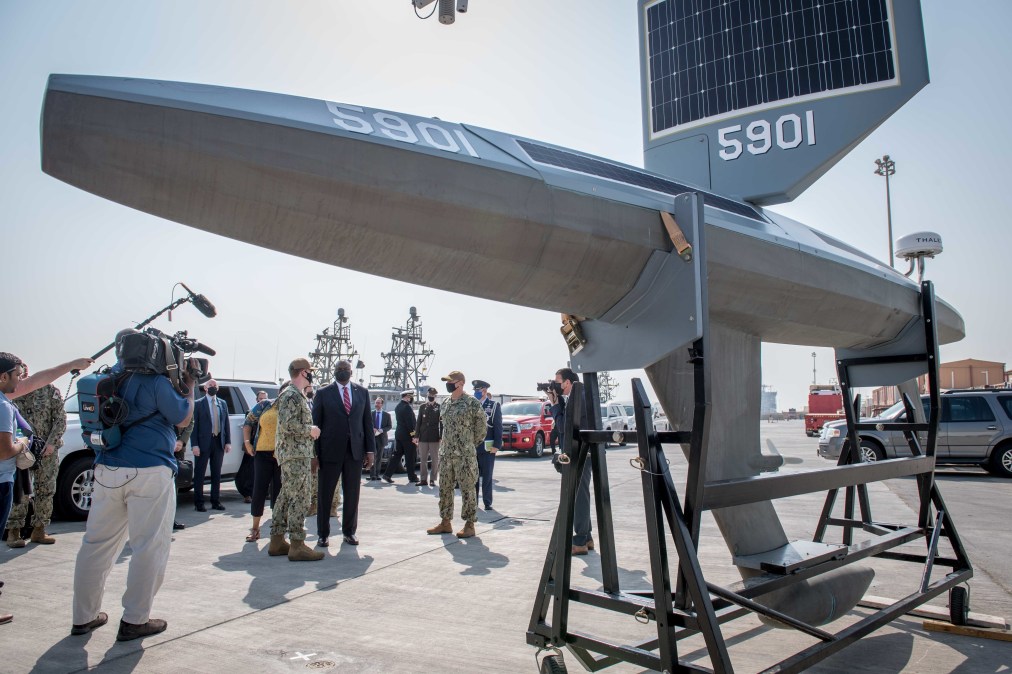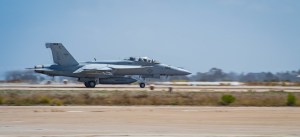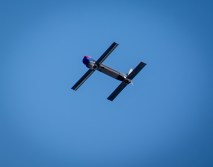Task Force 59: The future of the Navy’s unmanned systems or a one-off win?

The Navy faces a predicament: As threats grow in open waters across the globe — especially in the areas like the Indo-Pacific and the Middle East — the service is trying to build a future where it can keep its eyes open to those threats while working with a possibly shrinking budget.
How does the Navy plan to keep watch for everything from hostile Iranian drones to an aggressive Chinese posture to rogue pirates?
Robots.
At least, that’s the plan for the Navy’s Middle Eastern contingent, the Fifth Fleet, where an acute nexus of manning the watch over a hostile region is colliding with diminishing resources. At the heart of the effort — to deliver unmanned systems to extend the vision of Naval Forces Central Command — is a group of 21 sailors, many of whom are reservists, that are catching the eyes of senior leaders in the Pentagon.
Task Force 59 launched in September and already is testing tech in the water, collaborating with foreign militaries and earning shout-outs from the Navy’s top sailor. (Chief of Naval Operations Adm. Mike Gilday said in January the task force is “catching fire.”) It’s now in the midst of helping lead an exercise with 80 unmanned systems from 10 different countries.
The task force’s goal is to deliver “deterrence by detection,” meaning having unmanned systems chock full of sensors to increase the eyes and ears sailors have across the oceans. It’s a technical challenge that requires everything from building robots, artificial intelligence models and complex IT systems to orient unmanned systems along with those that are manned.
But, is a group of sailors — nearly half of whom are reservists on temporary assignment — an example of success the Navy can scale to meet its needs? Or is it just another experiment that will only yield one-off results?
Building a team
The task force’s commodore, Capt. Michael Brasseur, says it is less about the size and more about the experience of his team. By bring on reservists, Task Force 59’s roster includes the CEO of a 1000-person cybersecurity company; a D.C. think-tanker working toward a Ph.D. from Harvard and an advisor who was one of Snapchat’s earliest employees.
“This is not the B team,” Brasseur said in an interview.
“I was floored by the caliber of people,” Cmdr. Tom McAndrew, the task force’s No. 2, said in a separate interview.
But the model that has brought in such a high caliber of people might mean that it is harder to replicate and eventually scale the successes it reaches. Ten of the 21 members are reservists, including McAndrew, meaning eventually they will go back to their day jobs outside the Navy.
“We certainly recognize the importance of developing a more sustainable staffing model and have already begun working toward this transition,” NAVCENT spokesperson Cmdr. Tim Hawkins said.
What’s under the hood?
The task force so far has put a saildrone and other vessels with unmanned capabilities in the water. But what Brasseur and McAndrew are most excited about — but at this point have yet to share details of — is the tech stack and IT that power the unmanned systems.
“While I think the boats and physical things get a lot of recognition, one of the most difficult things to do is the IT environment,” said McAndrew.
Brasseur said the Task Force has a company on contract to build the user interface. He wouldn’t specify what firm but promised it has shown great PowerPoint slides so far. Both Brasseur and McAndrew were shy to share what they have built as the IT is still in a test and evaluation mode, saying so far the most important thing they have is the team of sailors building and using it.
“Never before have I seen so few do so much, so fast,” Brasseur said. “Everyone is focused on the robots, but we are building a data infrastructure to support a place where we can exploit with AI and ML.”
What does this mean for the rest of the Navy?
“I like the idea they are bringing in smart new people. I am sold that would work. But I think the problem with that is it’s not a scalable model,” Bryan Clark, a senior fellow at Hudson Institute, said in an interview.
Defense expert Melanie Sisson, a fellow at the Brookings Institute, warned against experimenting for experimentation’s sake. Beyond finding the right technology, she stressed the importance of finding the right use cases for the right technology for the task force’s success.
“The military is struggling to understand functionally what it will need to do,” Sisson said.
And where Task Force 59 sees senior leader buy-in, Clark warns of a “shell game” for what success means. How much the success of Task Force 59 will mean in success for the Navy can’t be known — but both Clark and Sisson warn that the key will be translating tech to the needs of operators.
“The Navy has a history littered with these programs that have come and gone,” Clark said.
It’s a point Task Force 59 says it can’t agree with more. The goal of the experiments, Brasseur said, is to get as much feedback as possible from operators — getting “kit in hands,” as he said.
“We have real problems and we are focused on solving real problems,” Brasseur said. “We are not tinkering.”
The feedback the task force is hoping to generate is also being shared with a broader set of technologists across the Navy. The Navy’s Joint All Domain Command and Control (JADC2) contribution, the Project Overmatch office, is clued into the work being done in the Middle East along with other unmanned task forces. JADC2 is the military’s new strategy to combined data from sensors across the battlefield, be they unmanned systems or manned sensors, into a military Internet of Things.
So far, much of the feedback Brasseur said he has gotten has been positive.
“We are trying to build real capability — we don’t have time or resources to do anything but that,” he said.




